

February 03: LEGL93-138. Yackandandah Creek Catchment in North Eastern Victoria. This catchment has been logged within a short space of time. This photo reveals that several kilometres of pine have recently been removed. Young plantation trees will have a significant impact on water yield as they grow. It has been estimated that 1 hectare of pine plantations will use approximately 2 million litres of water per year more than if that area was retained as pasture. In the long term, plantations are 'thirstier' than native forests because plantations are kept 'forever young', meaning that they will constantly be 'drinking' water. Native forests managed on longer rotations of 80 years, will eventually use less water than plantations because at about 35 years old trees start to slow down their water intake. The longer trees stay in the ground after 35-40 years the less impact these trees will have on water quantity in comparison to young water hungry trees less than 30 years old. Hancock is not paying for the water that their plantations are using. This unaccounted subsidy could amount to billions of dollars over time, given that Hancock control over 250,000 hectares of plantations and native forest throughout Victoria - most of which is logged in rotations of 28 to 34 years. Greenhouse predictions show that rainfall in north-eastern Victoria could decrease by 30% by the year 2030. Note also the smoke haze in this photo which enveloped much of North East Victoria during January and March. 1.2 million hectares of native forest was burnt during the fires - Victoria's worst since 1939.
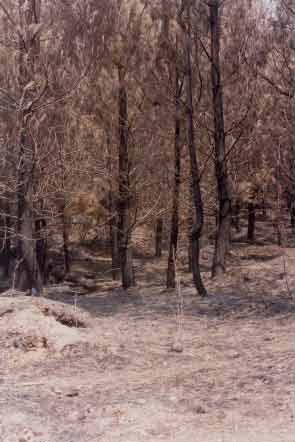
February LEGL93-138. Close up of the damage caused by bushfires in the Beechworth area. Hancock lost approximately 2000 hectares in the north east and several hundred hectares of bluegum and pine in the Gippsland area. Bushfires in the Canberra region destroyed approximately $20 million worth of pine plantations. It has been estimated that under Greenhouse Scenarios, bushfires in south east Australia will become more common during the 21st Century, meaning that many land uses such as plantation forestry could face spiralling insurance costs.
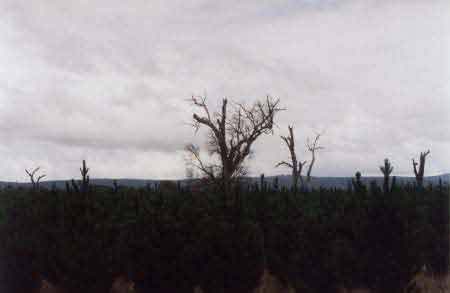
March 03: Grand Ridge Plantations - Rosedale (Central Gippsland). In 2002 locals in Gippsland reported that numerous trees were dieing in a pine plantation owned by Grand Ridge (Hancock). It appeared that potentially hundreds of old growth redgums (many over 150 years in age) had been poisoned by herbicide application in the pine plantation. These remnant trees were of extreme ecological significance and Hancock has been forced to replant thousands of trees as an act of remediation. Apparently the poisoning occurred under management prior to the take over by Hancock, but this has not as yet been confirmed. Whatever the scenario, this is a terrible inditement on the effects of herbcides on the natural environment.

March 03: Strzelecki Ranges - Morwell River East Branch Rainforest: Over the past few years Hancock Watch has been attempting to highlight the plight of cool temperate rainforest in the Strzelecki Ranges. Most of our attention has been focussed on the rainforests that were controlled by Victorian Plantations Corporation on the southern side of the Strzeleckis. There are of course cool temperate rainforests on the northern slopes of the Strzeleckis on land that was controlled by Australian Paper Plantations (APP). When Hancock took over the assets of APP in August 2001, they also took over the custodial role of protecting the surviving rainforest on the northern slopes. Hancock Watch has highlighted College Creek (a northern aspect rainforest) in the past. Over the next few months we will also place attention of other rainforests of the northern slopes such as Morwell River East Branch. Although somewhat more 'degraded' than other rainforests in the region, Morwell River East Branch rainforest still is of significant conservation importance. Hancock Watch is supporting initiatives to protect the Morwell River East Branch rainforests with buffers of at least 100 metres. Rainforest on the northern slopes of the Strzeleckis also occurs most notably in the Middle Creek catchment with cool temperate rainforest 'isolates' also occurring in the Jeeralang Creek and Traralgon Creek catchments. 100 metres buffers are required on Morwell River East Branch rainforest in order to protect this area from the impacts of the disease Myrtle Wilt and possible impacts of wildfire.
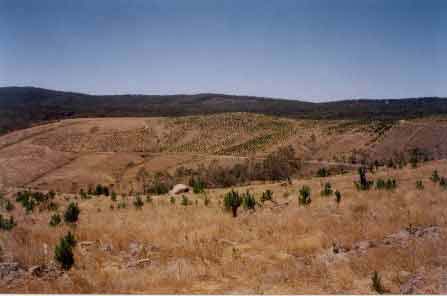
February 03: LEGL93-35. Lunatic Gully near the headwaters of the Wimmera River System- Central West Victoria. Hancock Watch was shocked to see the headwaters of the Wimmera River in such poor shape. About 1000 hectares of the headwaters of the river are controlled by Hancock. This area had been logged by Hancock in the past year. Young trees growing in the major recharge area of the river will deny freshwater flows downstream. (see recent Age Newspaper Article). Although Hancock cannot be blamed for establishing the plantations in this vital area, there has to be some onus on the company to replant indigenous species buffers along drainage lines and filter strips.
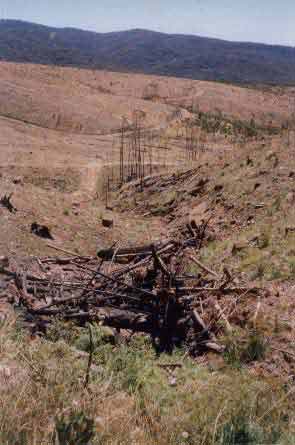
February 03: LEGL93-35. Headwaters of Lunatic Gully in the Wimmera River proclaimed water catchment- Central West Victoria. Logging debris bulldozed into drainage lines and torched. These gullies also had a large amount of disturbed soil in them, meaning that after rainfall this sediment may find its way into the Wimmera River. These areas require at least 20 metre buffers of native vegatation so that the above problems are not repeated in 20 years time!
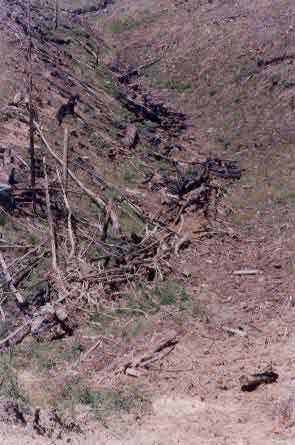
February 03: LEGL93-35. Headwaters of Lunatic Gully - Central West Victoria. More logging debris bulldozed into gullies and torched. This photo was taken several months after the logging, meaning that the site would have looked much worse.

February 03: LEGL93-35. Headwaters of the Lunatic Gully in the Wimmera River catchment - Central West Victoria. Snig tracks bulldozed straight into main gully. Note lack of buffer vegetation that protects the gullys from excessive sedimentation.
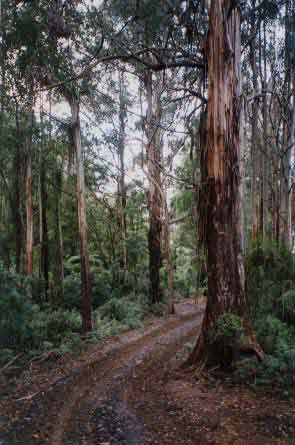
March 03: LEGL93-78 Morwell River West Branch - Dave's Track. This coupe was quite a good example of Hancock's logging operations in their hardwood estate. Note that the larger non-planted trees have been retained and it was obvious that quite good buffer zones and vegetation had been retained along gully lines and tributaries of the Morwell River West Branch. This coupe was a definite improvement, however logging had not yet ceased at the site.

March 03: LEGL93-78 Morwell River West Branch - Coupe off Livingston Road. This coupe was also an improvement on past hardwood logging by Hancock. Older trees had been retained and buffers left to protect water quality. Buffers should have been extended at this coupe by several metres but the coupe shows signs of definite improvement.
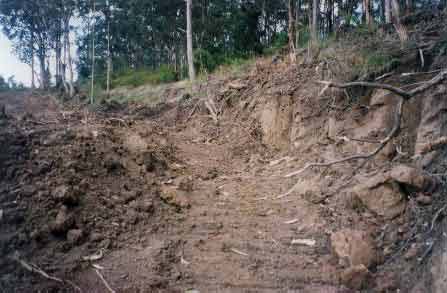
March 03: Pine plantation off Red Hill Road - Strzelecki Ranges (Stony Creek catchment). This was a site once under the management of Australian Paper Plantations and it shows! This is a totally inappropriate snig track cut alongside the headwaters of Stony Creek. Hancock's pine plantation management in the Strzleleckis still has room for massive improvements. This is very likely to breach the Code of Forest Practices.
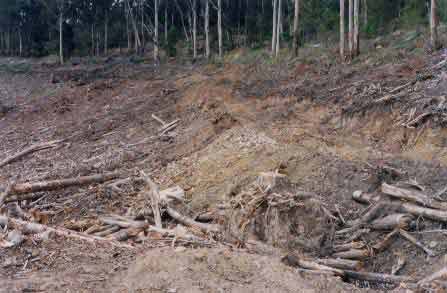
March 03: Pine plantation off Red Hill Road - Strzelecki Ranges (Stony Creek catchment). Another view of this appalling snig track.
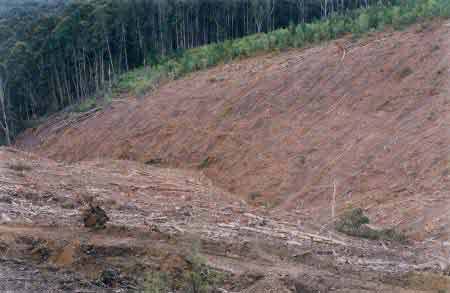
March 03: Pine plantation off Red Hill Road - Strzelecki Ranges (Stony Creek catchment). Note total lack of gully vegetation in this old pine plantation. This shot encapsulates the issues confronting pine plantations in the Strzeleckis. Many were established without environmental care principles - meaning that if they were problematic 30 years ago, they'll be problematic when logged. Much of this slope needs to be retired and revegetated with indigenous vegetation.
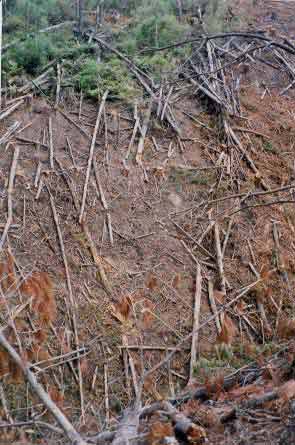
March 03: Pine plantation off Red Hill Road - Strzelecki Ranges (Stony Creek catchment). Note obvious steepness of gully. Trees cut into gully and left behind. What happens to this gully now?
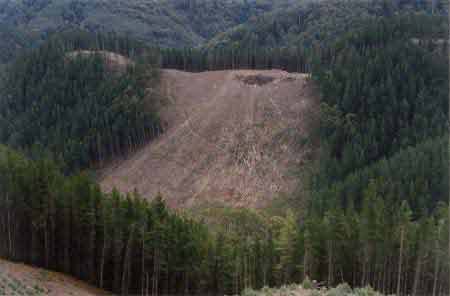
March 03: Pine cable logging in the Traralgon Creek catchment on ex-Australian Paper Plantation land. Is this practice sustainable?
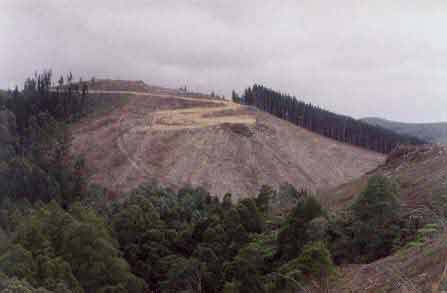
March 03: Cable logging of pine plantations in the Morwell River East Branch catchment. It's encouraging to see the retained gully revegetation, but one has to question the long term sustainability of logging on slopes such as these. One also has to question the impact of heavy rainfall on this unprotected soil. The Strzelecki's is in the grips of a seven year drought. Locals fear that once the drought breaks, unsustainable logging operations will create massive erosion problems.